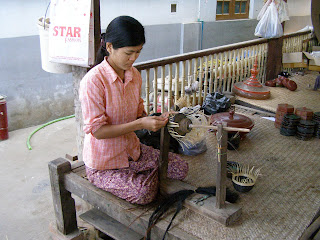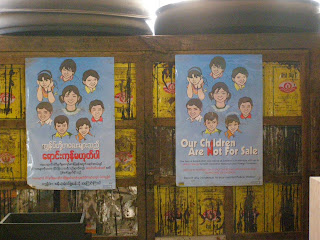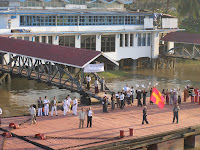
The alarm clock was set for 4:15am - "O Dark Hundred", in military parlance. We had to rise, leave the boat and catch an airplane for the 80 minute flight from Rangoon to Pagan. We had one of the more bizarre airport experiences in modern memory. As our police escort rushed us to the spot right in front of the door to the terminal, we prepared to tumble off the bus. As we descended, we were handed boarding passes and told to proceed through the front doors. Metal detectors screamed as we piled through, waved on by uniformed officials. Another set of authorities herded us through security - again ignoring all warnings of the bombs in our daypacks. We basically went straight through the terminal and onto the runway bus, which took us to our waiting little ATP aircraft. As we scrambled aboard, the props started turning. We sat back and the doors were locked. Time from airport arrival to pushback: 9 minutes!

>

Why the hurry? Our minders knew we should see the sunrise over Pagan, and they were right.
We settled into the flight and examined the land below as the light came up. Broad rice terraces were consistent with the agricultural empire the Brits had built: Burma used to be the top rice-producing/exporting nation in the world. Now they have to import rice to feed their people. As we approached Pagan, we could see a broad, dry valley with rice lands on either side. This layout was the secret to the survival of 2,000 of the 4,000 temples of the kingdom of Pagan. When the kingdom fell in the 13th century, invaders seized the productive areas on either side of Pagan, but left the arid capital, with its myriad temples, to bake in the sun. This spared the temples the fate of being harvested for their stones and turned into monuments for the conquerors. With the simple straw and mud buildings of the common people melted away long ago, the effect of the 2,000 temples rising from the plain in the middle of nowhere is eerie and gorgeous.


Climbing to the terrace of one of the tallest temples gave us a sense of what we were to explore over the course of a long, wonder-ful day.


The day was balanced by glimpses of the contemporary people of Pagan going about their business. This was undoubtedly part of a strategy to avoid temple-overload, but it was interesting in its own right. Here are some scenes from the environs of that first temple. A woman watering the (meager) plantings on the temple grounds.

A sweeper - this lady was extremely old and very shy.

Here is a local bus full of tourists. By the time it took off, baskets were strapped to the back and people were perched on the roof - no inch of space was wasted.

We went to the local market, where women were weighing (round) eggplants and sorting great piles of shallots. The produce was beautiful, as you can see from these eggplants and cucumbers. I had never seen such huge okra - each pod was about 12 inches long. People were curious about us and, like everywhere we went in Burma, the women wanted to buy our lipsticks (?). The men were after Bryan and others asking to buy their watches - someone offered Bryan $20 for his used Timex! I guess I know what to bring along next time we go...



It was time to get back to the temples. Our next stop was the Shwezigon temple, one of the oldest temples, dating back to around 1000. This striking-looking stupa is ground-zero in Burma's fight with UNESCO, which has denied World Heritage Site status to Pagan. In the 1980's, as part of post-earthquake repairs to the temple, great copper plates were installed and a massive gilding began. In part, the generals of the junta sought to reassure the people that they were good guys (and to gain a bit of merit for themselves).

This, along with the unsupervised (by Western historians/archaelogists/art historians) repair of earthquake damage and the construction of a couple of modern hotels and a museum of archaeology in the area, rendered it impossible for UNESCO to grant the status that would have put Pagan on the must-see map of many people who do not otherwise have the imagination to know about it. Locals are very cynical about the political implications here....

We had time to participate in the local economy a bit before lunch. The trip to the lacquer factory is a staple of Southeast Asian travel. This one was a bit different, though, in that the final product really was a cut above the ordinary. Like many things in Burma, it seems that the modern pace of life has not yet taken over - this means more layers of lacquer, longer drying periods, more careful application of gold and color.
 This young woman is weaving straw and horsehair into the base of a black laquer cup that can hold hot or cold water and is flexible!
This young woman is weaving straw and horsehair into the base of a black laquer cup that can hold hot or cold water and is flexible! The charm of the carefully crafted "simple people at work" scene was a bit undermined by this set of posters, in Burmese and English....One doesn't like to contemplate.
The charm of the carefully crafted "simple people at work" scene was a bit undermined by this set of posters, in Burmese and English....One doesn't like to contemplate.

After lunch at a resort along the banks of the Irawaddy, we went onto the next treat of the day. There are few paved roads into the temple area, but the temples are connected by myriad little dirt trails. Some tourists rent bicycles to explore the temples...others go about in little horse carts. Our driver was named Joe and his horse was called...Rambo.


Joe and Rambo got us up close so we could see the individual temples. Here is one that clearly shows the repairs done after the earthquake in 1975. It may not be an elegant fix, but at least it is clear what was damaged and what was done to hold it together.

 It is interesting to see the contemporary people living among the temples. You can see the straw dwellings the repair workers build to live alongside their workplaces.
It is interesting to see the contemporary people living among the temples. You can see the straw dwellings the repair workers build to live alongside their workplaces. Folks around Pagan tend fields of crops such as soy beans and vegetables. They gather firewood and they use their bullock carts to get to the markets when the bullocks are not plowing the fields.
Folks around Pagan tend fields of crops such as soy beans and vegetables. They gather firewood and they use their bullock carts to get to the markets when the bullocks are not plowing the fields.

We stopped to see the beautiful Ananda temple, the top of which was gilded by the generals in 1990, as a 1000th birthday gift to this treasured temple. The exterior is stunning and the interior has four huge Buddhas.


While the golden Buddhas were awe-inspiring, the ancient, polished hallways were quietly serene and beautiful. In another temple, we used flashlights to see frescoes done by ancient monks on just such hallways. There were scenes with white elephants and palm trees and the human images looked for all the world like the Hindu paintings in India.

We passed up the opportunity to use this local equivalent of a waterfountain on our way out of the temple complex.

We were headed back to the airport now. The afternoon light was just gorgeous, though, and we begged our busdriver to stop and let us wander around this pottery market, taking pictures, for a few minutes.





 The sights were superb, but the people of Burma will stay with us forever. We wish them well and hope to explore a free Burma one day.
The sights were superb, but the people of Burma will stay with us forever. We wish them well and hope to explore a free Burma one day.

























































